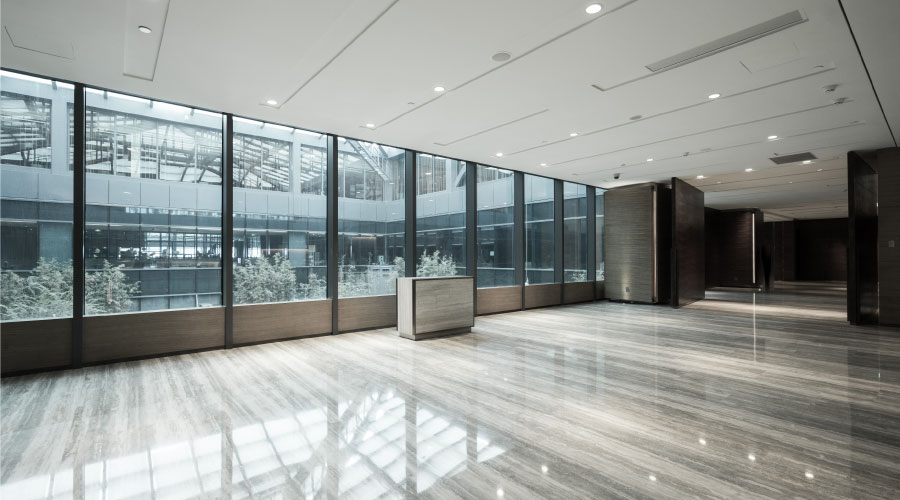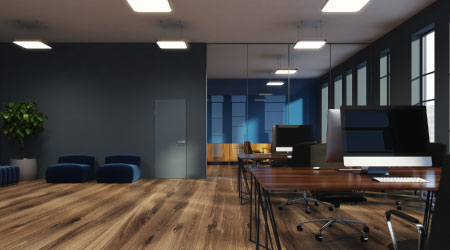Considering the Life-Cycle Cost of Flooring
Looking beyond first costs on flooring projects can mean overall savings
Of all the materials in a facility, flooring is arguably the most visible. Other building components and finishes draw the eye, but flooring is always within view. Visually, it’s an important element in setting the mood of the facility. Facility occupants and visitors will be put off by a floor that doesn’t look its best.
Besides looking good, flooring has to stand up to an enormous amount of wear and tear. No other product in a facility will have to endure such near-constant use.
Because of its visual importance and the sheer amount of product needed, flooring can be a major expense. That doesn’t mean facilities executives should overspend, however. Life-cycle costing is a process that can help facilities executives understand exactly what a floor will cost over its lifetime and ensure that a product chosen will meet the needs of a facility.
Life-cycle cost gives facilities executives a big picture view of the flooring options being considered. But life-cycle costs are often overshadowed by first cost because of tight budgets during construction. By the time a floor is installed towards the end of construction, spending has often gone over budget. This can lead to cutting costs on flooring.
What’s worse, some facilities executives just don’t think it’s necessary to consider long-term costs. “Some facilities executives think life-cycle costing is all just smoke and mirrors,” says Bill Croswell, CEO and owner, CraftCroswell, and a member of StarNet. “They aren’t interested in figuring out the life-cycle costs of flooring.”
Life-cycle costing isn’t a difficult process, but it can be time consuming and involve complex factors. But time spent to calculate life-cycle costs is well worth the return — savings years down the road.
The general tenet of life-cycle costing is that the least expensive flooring product might actually cost more in the long run than a product that is initially more expensive. To see whether this is true for a particular space, facilities executives should examine each flooring product carefully.
Life-cycle cost is comprised of the total dollars expended over the usable life of a flooring installation, says David Meberg, president and CEO, Consolidated Carpet, a StarNet member. It generally includes the first cost of the flooring, cost of installation (including the cost of disruption to business, if applicable), the cost of maintenance over the expected service life of the flooring, and disposal, reclamation, and removal costs. The total cost is then divided by the number of years the floor is expect to last, resulting in a total cost per year. That figure can then be divided further into cost per square foot or other appropriate metrics. Calculating the life-cycle cost for all flooring products being considered allows facilities executives to compare them on even ground.
Balancing Act
Choosing the best flooring for a particular facility includes analyzing the work the occupants do in the space, how often they do it and how each flooring option will hold up to it. Aesthetics should also be taken into account, as well as maintenance, cost and any special requirements, such as slip-resistance or hygiene.
Considering all these factors makes product selection a balancing act. Some spaces will require flooring designed for specific needs. The need for hygiene in a hospital operating room, for example, may call for sheet vinyl that is aseptically heat welded.
In other cases, however, the answer may not be so apparent. The choices for hard surface flooring in a retail setting are abundant. Here, aesthetics often plays a large role, as does durability because of heavy traffic and possibly heavy loads of products and fixtures. Facilities executives should rank the requirements of the flooring and balance them with wants. For example, the owner of a busy clothing store with heavy rolling garment racks that are often repositioned may want the look of ceramic tile flooring, but that choice would not be practical or cost-effective. Rolling the racks would be difficult, and under the heavy traffic, the tile would need constant repairs. Facilities executives might want to consider a high-pressure laminate or luxury vinyl tile (LVT) that would give the appearance desired but have more durability.
Maintenance Matters
Projected maintenance costs are often the most important factor in life-cycle cost. “A facility will spend more money on maintaining a floor than on the initial purchase,” says Harold Chapman, president, Bonitz Flooring Group, a StarNet member.
The longer a floor lasts, the greater the number of years initial costs can be divided into, which often results in savings in the long run. Generally, it costs less to maintain an existing floor than to install a new floor. There comes a point, however, when new flooring with fewer routine maintenance needs would be more cost-effective. For example, 20-year old vinyl composition tile (VCT) in a high traffic area might require stripping and waxing twice a month. The age of the product coupled with continued high maintenance costs could mean a new, lower maintenance floor — carpeting or high-pressure laminate, for example — would actually save the facility money long term.
Factoring in Upkeep
The required maintenance to keep a floor attractive and functional is based on two factors: the product itself and the type and amount of use the floor receives.
Different types of flooring require different regular maintenance. Carpeting, for example, benefits from a phased cleaning program, says Meberg. A professional carpet cleaner can analyze a facility and recommend a routine maintenance program. That includes vacuuming based on the level of use. If dirt and grime are allowed to sink into the carpet, they can cut the fibers and cause irreparable damage. Beyond routine vacuuming, certain areas in the facility might require deep cleaning every month, every other month, or on an as-needed basis.
Linked to the maintenance costs, says Meberg, is the use of walk-off areas at the entrances of buildings. In a multistory office building, for example, a properly selected walk-off system will generally have removed dirt from occupants’ shoes by the time they reach the carpet outside the elevator on their office floors.
Maintenance costs need to be balanced with first costs. VCT is often one of the least expensive flooring products and is generally very durable. However, the level of maintenance required to keep a VCT floor looking good might overwhelm the lower initial cost. In a high-traffic area where appearance is important, facilities executives should consider flooring that is more expensive but requires less maintenance. “Facilities executives will soon forget the savings they got by going with a less expensive product once they realize how much is being spent on maintenance,” says Chapman.
Proper maintenance of flooring is essential to keep the floor looking good. The length of time a flooring product is expected to stay attractive is called appearance retention. This is a critical factor in life-cycle costs because flooring will usually be replaced if it no longer looks good. Unless a building’s owner and occupants really don’t care how the floor looks, appearance retention is key. “A facilities executive wants the floor to look as new as possible for as long as possible,” says Croswell. If flooring looks stained and worn, it’s going to be replaced. The rated service life of a product doesn’t matter if it’s not properly maintained to keep an acceptable appearance.
Green Endings
Facilities executives who don’t consider life-cycle cost for flooring are often surprised by another set of costs when the time comes to dispose of flooring that has been removed, says Meberg. Other than maintenance, these are often the most costly and overlooked expenses in flooring. “If facilities executives don’t take into account what the product’s end-of-life will be, there will be a surprise cost they didn’t bargain for,” he says.
Included in the end-of-life cost is the labor for flooring removal, which varies with different types of flooring, the cost to transport the material to a landfill or disposal site, and the fee charged by the landfill, if applicable. This can all add up to a costly surprise if it wasn’t considered at the beginning of the purchasing process.
Recently, the green movement has had a large impact on the end-of-life costs for flooring. “Some manufacturers are taking the lead in the green movement because customers are demanding green products,” says Croswell. This translates into products — particularly carpet tile — that can be recycled at the end of their lives rather than going to a landfill.
“Carpet manufacturers are now starting to focus on regeneration and reuse of materials,” says Meberg. “They bring in old material, break it down into a raw component and reuse that in the manufacture of new products.”
It used to be that facilities executives would have to pay to transport carpet tiles to the recycling facility, therefore only saving on landfill costs. But more recently, manufacturers are getting such an increase in demand for recycled-content products that many offer the reclamation services at no charge, says Meberg. Manufacturers are removing carpet tiles at no cost to the facility, which translates into almost no end-of-life costs.
About Starnet
StarNet is a commercial flooring cooperative comprised of locally owned full service commercial flooring contractors throughout North America. Since it was founded in 1992, membership has grown to more than 150 independent members.
To become a member, a flooring contractor must meet strict standards, including a history of successful flooring installations in its market area as shown by client testimonials and demonstrated financial stability. Potential members must also agree to attend StarNet’s annual meeting.
For facilities executives and contractors, StarNet’s Web site offers a technical library of downloadable publications called StarLog. Topics include environmentally friendly flooring, information on various types of commercial flooring and safety during installation, among others.
StarNet also sponsors an annual flooring design award that recognizes innovation in creative flooring installations. The StarNet member entries are judged on the creative use of flooring, the overall design concept and how well the design meets client objectives and challenges.
|
Finding Middle Ground
It’s important to remember that a floor’s rated service life is based on averages. Carpeting may have a rated service life of 10 years, but extremely high traffic may shorten the service life of the carpet significantly.
Even so, a product’s rated service life is still an important consideration when calculating life-cycle costs. A grossly overestimated service life can cost money in early replacement. But a longer service life isn’t always a better value. Flooring with a rated service life of 30 years will generally cost more than a floor only rated for five years.
If facilities executives know the facility has a high rate of churn and spaces are being remodeled or upgraded every 10 years, purchasing the flooring with a service life of 30 years isn’t necessary.
|
Related Topics:











